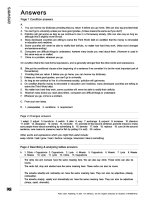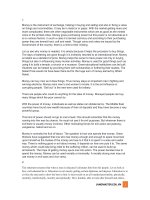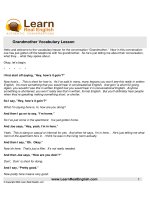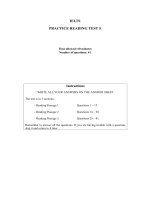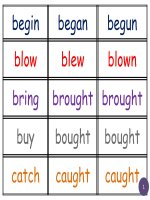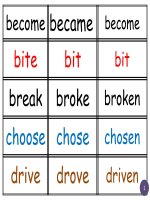English gramma workbook for dummies kho tài liệu học tiếng anh
Bạn đang xem bản rút gọn của tài liệu. Xem và tải ngay bản đầy đủ của tài liệu tại đây (9.74 MB, 316 trang )
Spine: .7027"
100s
of Problems!
Practice is the key to improving your grammar skills, and that's what this
workbook is all about. Honing your speaking and writing skills helps you
in everyday situations, such as writing papers, giving presentations, and
communicating effectively in the workplace or classroom. Here you’ll
find hundreds of problems to help build your grammar muscles. With a
little practice every day, you'll be speaking correctly, writing confidently,
and getting the recognition you deserve at work or school.
Detailed reviews and
explanations of everyday
English grammar
Tips for acing standardized
tests and workplace
communication
The latest rules on writing
for electronic media
Geraldine Woods is a high
school English teacher and
author of more than 40 books.
planations
Quick refresher ex
e exercises
Hands-on practic
tions to test your
A variety of ques
knowledge
y-step
for videos, step-b
to shop!
how-to articles, or
k
o
o
b
k
r
Wo
Write papers, give
presentations, and
communicate effectively
Score your highest on
standardized tests
ISBN 978-0-470-93070-0
Geraldine Woods
$16.99 US
Language Arts/Grammar & Punctuation
2nd Edition
r
a
m
m
a
r
G
h
s
i
l
g
En
Structure sentences correctly,
make subjects and verbs
agree, and perfect your
punctuation
com®
G o to Dummie s.
examples,
t
Online Cheat Shee
and fun
A dash of humor
$19.99 CN
™
2nd Edition
English Grammar Workbook
Get some good grammar practice —
and start speaking and writing well
g Easier !
Making Everythin
Woods
Author of English Grammar For Dummies
Get More and Do More at Dummies.com ®
Start with FREE Cheat Sheets
Cheat Sheets include
• Checklists
• Charts
• Common Instructions
• And Other Good Stuff!
To access the Cheat Sheet created specifically for this book, go to
www.dummies.com/cheatsheet/englishgrammarwb
s
p
p
A
e
Mobil
Get Smart at Dummies.com
Dummies.com makes your life easier with 1,000s
of answers on everything from removing wallpaper
to using the latest version of Windows.
Check out our
• Videos
• Illustrated Articles
• Step-by-Step Instructions
Plus, each month you can win valuable prizes by entering
our Dummies.com sweepstakes. *
Want a weekly dose of Dummies? Sign up for Newsletters on
• Digital Photography
• Microsoft Windows & Office
• Personal Finance & Investing
• Health & Wellness
• Computing, iPods & Cell Phones
• eBay
• Internet
• Food, Home & Garden
There’s a Dummies App for This and That
With more than 200 million books in print and over 1,600 unique
titles, Dummies is a global leader in how-to information. Now
you can get the same great Dummies information in an App. With
topics such as Wine, Spanish, Digital Photography, Certification,
and more, you’ll have instant access to the topics you need to
know in a format you can trust.
To get information on all our Dummies apps, visit the following:
www.Dummies.com/go/mobile from your computer.
Find out “HOW” at Dummies.com
*Sweepstakes not currently available in all countries; visit Dummies.com for official rules.
www.Dummies.com/go/iphone/apps from your phone.
r
a
m
m
a
r
English G
k
o
o
b
k
r
o
W
FOR
S
E
I
m
DUM
‰
2ND
EDITION
by Geraldine Woods
01_9780470930700-ffirs.indd i
2/22/11 3:27 PM
English Grammar Workbook For Dummies®, 2nd Edition
Published by
Wiley Publishing, Inc.
111 River St.
Hoboken, NJ 07030-5774
www.wiley.com
Copyright © 2011 by Wiley Publishing, Inc., Indianapolis, Indiana
Published simultaneously in Canada
No part of this publication may be reproduced, stored in a retrieval system or transmitted in any form or
by any means, electronic, mechanical, photocopying, recording, scanning or otherwise, except as permitted under Sections 107 or 108 of the 1976 United States Copyright Act, without either the prior written
permission of the Publisher, or authorization through payment of the appropriate per-copy fee to the
Copyright Clearance Center, 222 Rosewood Drive, Danvers, MA 01923, (978) 750-8400, fax (978) 646-8600.
Requests to the Publisher for permission should be addressed to the Permissions Department, John Wiley
& Sons, Inc., 111 River Street, Hoboken, NJ 07030, (201) 748-6011, fax (201) 748-6008, or online at http://
www.wiley.com/go/permissions.
Trademarks: Wiley, the Wiley Publishing logo, For Dummies, the Dummies Man logo, A Reference for the
Rest of Us!, The Dummies Way, Dummies Daily, The Fun and Easy Way, Dummies.com, Making Everything
Easier, and related trade dress are trademarks or registered trademarks of John Wiley & Sons, Inc. and/
or its affiliates in the United States and other countries, and may not be used without written permission.
All other trademarks are the property of their respective owners. Wiley Publishing, Inc., is not associated
with any product or vendor mentioned in this book.
LIMIT OF LIABILITY/DISCLAIMER OF WARRANTY: THE PUBLISHER AND THE AUTHOR MAKE NO
REPRESENTATIONS OR WARRANTIES WITH RESPECT TO THE ACCURACY OR COMPLETENESS OF
THE CONTENTS OF THIS WORK AND SPECIFICALLY DISCLAIM ALL WARRANTIES, INCLUDING WITHOUT LIMITATION WARRANTIES OF FITNESS FOR A PARTICULAR PURPOSE. NO WARRANTY MAY BE
CREATED OR EXTENDED BY SALES OR PROMOTIONAL MATERIALS. THE ADVICE AND STRATEGIES
CONTAINED HEREIN MAY NOT BE SUITABLE FOR EVERY SITUATION. THIS WORK IS SOLD WITH THE
UNDERSTANDING THAT THE PUBLISHER IS NOT ENGAGED IN RENDERING LEGAL, ACCOUNTING, OR
OTHER PROFESSIONAL SERVICES. IF PROFESSIONAL ASSISTANCE IS REQUIRED, THE SERVICES OF
A COMPETENT PROFESSIONAL PERSON SHOULD BE SOUGHT. NEITHER THE PUBLISHER NOR THE
AUTHOR SHALL BE LIABLE FOR DAMAGES ARISING HEREFROM. THE FACT THAT AN ORGANIZATION OR WEBSITE IS REFERRED TO IN THIS WORK AS A CITATION AND/OR A POTENTIAL SOURCE
OF FURTHER INFORMATION DOES NOT MEAN THAT THE AUTHOR OR THE PUBLISHER ENDORSES
THE INFORMATION THE ORGANIZATION OR WEBSITE MAY PROVIDE OR RECOMMENDATIONS IT
MAY MAKE. FURTHER, READERS SHOULD BE AWARE THAT INTERNET WEBSITES LISTED IN THIS
WORK MAY HAVE CHANGED OR DISAPPEARED BETWEEN WHEN THIS WORK WAS WRITTEN AND
WHEN IT IS READ.
For general information on our other products and services, please contact our Customer Care
Department within the U.S. at 877-762-2974, outside the U.S. at 317-572-3993, or fax 317-572-4002.
For technical support, please visit www.wiley.com/techsupport.
Wiley also publishes its books in a variety of electronic formats. Some content that appears in print may
not be available in electronic books.
Library of Congress Control Number: 2011921767
ISBN: 978-0-470-93070-0
Manufactured in the United States of America
10 9 8 7 6 5 4 3 2 1
01_9780470930700-ffirs.indd ii
2/22/11 3:27 PM
About the Author
Geraldine Woods teaches English and directs the independent study program at the
Horace Mann School in New York City. She is the author of more than 50 books, including English Grammar For Dummies, SAT For Dummies, Research Papers For Dummies,
College Admission Essays For Dummies, AP English Literature For Dummies, and AP
English Language and Composition For Dummies, all published by Wiley. She lives in New
York City with her husband and two parakeets. She loves the Yankees, Chinese food,
and her family.
01_9780470930700-ffirs.indd iii
2/22/11 3:27 PM
Dedication
For Elizabeth, who, as a toddler, already shows an aptitude for grammar. And for Harry,
forever in my heart.
Author’s Acknowledgments
I owe thanks to my colleagues at the Horace Mann School, who are always willing to
discuss the finer points of grammar. I appreciate the work of Vicki Adang, Caitie Copple,
Mike Greiner, and Penny Brown, fine editors whose hard work and intelligence made
this workbook much better than it would have been without them. I appreciate the
efforts of my agent, Lisa Queen of Queen Literary, and the kindness of Lindsay Lefevere,
Wiley’s acquisitions editor.
01_9780470930700-ffirs.indd iv
2/22/11 3:27 PM
Publisher’s Acknowledgments
We’re proud of this book; please send us your comments at . For other comments, please contact our Customer Care Department within the U.S. at 877-762-2974, outside the U.S. at 317572-3993, or fax 317-572-4002.
Some of the people who helped bring this book to market include the following:
Acquisitions, Editorial, and Media Development
Composition Services
Project Editor: Victoria M. Adang
Project Coordinator: Nikki Gee
(Previous Edition: Kristin DeMint)
Layout and Graphics: Carl Byers, Carrie A. Cesavice,
Mark Pinto, Corrie Socolovoitch, Christin Swinford
Executive Editor: Lindsay Sandman Lefevere
(Previous Edition: Kathleen M. Cox)
Copy Editor: Caitlin Copple
Proofreaders: Lindsay Amones, Melissa Cossell,
John Greenough, Betty Kish
Indexer: Steve Rath
(Previous Edition: Sarah Faulkner, E. Neil Johnson)
Assistant Editor: David Lutton
Technical Editors: Michael Greiner,
Penelope M. Brown
Editorial Manager: Michelle Hacker
Editorial Assistants: Rachelle Amick,
Jennette ElNaggar
Cover Photo: © iStockphoto.com/Natalia Lukiyanova
Cartoons: Rich Tennant (www.the5thwave.com)
Publishing and Editorial for Consumer Dummies
Diane Graves Steele, Vice President and Publisher, Consumer Dummies
Kristin Ferguson-Wagstaffe, Product Development Director, Consumer Dummies
Ensley Eikenburg, Associate Publisher, Travel
Kelly Regan, Editorial Director, Travel
Publishing for Technology Dummies
Andy Cummings, Vice President and Publisher, Dummies Technology/General User
Composition Services
Debbie Stailey, Director of Composition Services
01_9780470930700-ffirs.indd v
2/22/11 3:27 PM
Contents at a Glance
Introduction ............................................................................ 1
Part I: Building a Firm Foundation: Grammar Basics .................. 5
Chapter 1: Finding the Right Verb at the Right Time ....................................................................... 7
Chapter 2: Got a Match? Pairing Subjects and Verbs Correctly ................................................... 23
Chapter 3: Who Is She, and What Is It? Pronoun Basics ................................................................ 39
Chapter 4: Having It All: Writing Complete Sentences ................................................................... 53
Part II: Mastering Mechanics ................................................. 71
Chapter 5: Pausing to Consider the Comma ................................................................................... 73
Chapter 6: A Hook That Can Catch You: Apostrophes .................................................................. 87
Chapter 7: “Let Me Speak!” Quotation Marks .................................................................................. 97
Chapter 8: Hitting the Big Time: Capital Letters........................................................................... 107
Part III: Applying Proper Grammar in Tricky Situations .......... 117
Chapter 9: Choosing the Best Pronoun: Case, Number, and Clarity .......................................... 119
Chapter 10: Tensing Up: Choosing the Right Verb for Tricky Sentences .................................. 143
Chapter 11: Are You and Your Verbs in the Right Mood? ........................................................... 157
Chapter 12: Writing for Electronic Media ...................................................................................... 165
Part IV: Upping the Interest: Describing and Comparing ......... 175
Chapter 13: Writing Good or Well: Adjectives and Adverbs ....................................................... 177
Chapter 14: Going on Location: Placing Descriptions Correctly ................................................ 187
Chapter 15: For Better or Worse: Forming Comparisons ............................................................ 201
Part V: Improving Your Writing Style .................................... 219
Chapter 16: Staying on Track: Parallel Writing ............................................................................. 221
Chapter 17: The Writing Diet: Adding Spice and Cutting Fat from Your Sentences................. 237
Chapter 18: Steering Clear of Tricky Word Traps......................................................................... 247
Part VI: The Part of Tens ...................................................... 259
Chapter 19: Ten Overcorrections ................................................................................................... 261
Chapter 20: Ten Errors to Avoid at All Costs ................................................................................ 265
Appendix: Grabbing Grammar Goofs ...................................... 269
Index .................................................................................. 299
02_9780470930700-ftoc.indd vi
2/22/11 3:28 PM
Table of Contents
Introduction ............................................................................. 1
About This Book ................................................................................................................. 1
Conventions Used in This Book ........................................................................................ 2
What You’re Not to Read ................................................................................................... 2
Foolish Assumptions .......................................................................................................... 2
How This Book Is Organized ............................................................................................. 2
Part I: Building a Firm Foundation: Grammar Basics ........................................... 3
Part II: Mastering Mechanics ................................................................................... 3
Part III: Applying Proper Grammar in Tricky Situations ...................................... 3
Part IV: Upping the Interest: Describing and Comparing .................................... 3
Part V: Improving Your Writing Style ..................................................................... 3
Part VI: The Part of Tens .......................................................................................... 4
Icons Used in This Book .................................................................................................... 4
Where to Go from Here ...................................................................................................... 4
Part I: Building a Firm Foundation: Grammar Basics................... 5
Chapter 1: Finding the Right Verb at the Right Time . . . . . . . . . . . . . . . . . . . . . . . . .7
Using Past, Present, and Future Tense at the Right Times ........................................... 7
Putting Perfect Tenses in the Spotlight ........................................................................... 9
Hitting Curveballs: Irregular Forms................................................................................ 10
Getting a Handle on Common Irregulars: Be and Have ............................................... 12
Aiding and Abetting: Helping Verbs ............................................................................... 13
Calling into Question with Verbs .................................................................................... 14
Calling All Overachievers: Extra Practice with Verbs .................................................. 16
Answers to Problems on Verbs and Verb Tenses ........................................................ 17
Chapter 2: Got a Match? Pairing Subjects and Verbs Correctly . . . . . . . . . . . . . .23
When One Isn’t Enough: Forming Plural Nouns ........................................................... 23
Meeting Their Match: Pairing Subjects and Verbs ....................................................... 25
Taming the Brats: Choosing the Right Verb for Difficult Subjects ............................. 27
Not What They Seem: Dealing with Deceptive Subjects .............................................. 29
Calling All Overachievers: Extra Practice with Hitching Subjects and Verbs........... 31
Answers to Subject and Verb Pairing Problems ........................................................... 32
Chapter 3: Who Is She, and What Is It? Pronoun Basics . . . . . . . . . . . . . . . . . . . .39
Numbering Singular and Plural Pronouns ..................................................................... 39
Holding Your Own with Possessive Pronouns ............................................................. 41
It’s All in the Details: Possessives and Contractions ................................................... 43
Making Sure Your Pronouns Are Meaningful ................................................................ 44
Calling All Overachievers: Extra Practice with Basic Pronouns ................................. 47
Answers to Pronoun Problems ....................................................................................... 48
02_9780470930700-ftoc.indd vii
2/22/11 3:28 PM
viii
English Grammar Workbook For Dummies, 2nd Edition
Chapter 4: Having It All: Writing Complete Sentences . . . . . . . . . . . . . . . . . . . . . .53
Finding Subjects and Verbs that Match ......................................................................... 54
Checking for Complete Thoughts ................................................................................... 55
Improving Flow with Properly Joined Sentences ......................................................... 57
Setting the Tone with Endmarks .................................................................................... 60
Proper Sentence or Not? That Is the Question ............................................................. 61
Calling All Overachievers: Extra Practice with Complete Sentences......................... 64
Answers to Complete Sentence Problems .................................................................... 65
Part II: Mastering Mechanics .................................................. 71
Chapter 5: Pausing to Consider the Comma . . . . . . . . . . . . . . . . . . . . . . . . . . . . . . .73
Keeping Lists in Order with Commas and Semicolons ................................................ 73
Directly Addressing the Listener or Reader.................................................................. 75
Placing Commas in Combined Sentences...................................................................... 76
Inserting Extras with Commas: Introductions and Interruptions .............................. 77
Setting Descriptions Apart .............................................................................................. 78
Calling All Overachievers: Extra Practice with Commas ............................................. 80
Answers to Comma Problems ......................................................................................... 81
Chapter 6: A Hook That Can Catch You: Apostrophes . . . . . . . . . . . . . . . . . . . . . . .87
Tightening Up Text: Contractions .................................................................................. 87
Showing Who Owns What: Possessives......................................................................... 89
Calling All Overachievers: Extra Practice with Apostrophes ..................................... 91
Answers to Apostrophe Problems ................................................................................. 92
Chapter 7: “Let Me Speak!” Quotation Marks . . . . . . . . . . . . . . . . . . . . . . . . . . . . .97
Quoting and Paraphrasing: What’s the Difference? ..................................................... 97
Giving Voice to Direct Quotations .................................................................................. 98
Punctuating Titles .......................................................................................................... 100
Calling All Overachievers: Extra Practice with Quotation Marks............................. 102
Answers to Quotation Problems .................................................................................. 103
Chapter 8: Hitting the Big Time: Capital Letters . . . . . . . . . . . . . . . . . . . . . . . . . . .107
Paying Respect to People’s Names and Titles ............................................................ 107
Working with Business and School Terms .................................................................. 109
Capitalizing Titles of Literary and Media Works ........................................................ 110
Managing Capital Letters in Abbreviations ................................................................. 111
Calling All Overachievers: Extra Practice with Capital Letters ................................ 112
Answers to Capitalization Problems ............................................................................ 113
Part III: Applying Proper Grammar in Tricky Situations........... 117
Chapter 9: Choosing the Best Pronoun: Case, Number, and Clarity . . . . . . . . . .119
Meeting the Subject at Hand and the Object of My Affection ................................... 119
To “Who” or To “Whom”? That Is the Question ......................................................... 121
02_9780470930700-ftoc.indd viii
2/22/11 3:28 PM
Table of Contents
ix
Linking Up with Pronouns in “To Be” Sentences ........................................................ 122
You Talkin’ to Me, or I? Pronouns as Objects of Prepositions ................................. 123
Matching Possessive Pronouns to “-ing” Nouns ......................................................... 124
Missing in Action: Choosing Pronouns for Implied Comparisons............................ 125
Making Pronouns Get Along .......................................................................................... 126
Multitasking Pronouns: Who, That, and Which .......................................................... 128
Limiting Pronouns to Specific References ................................................................... 130
Calling All Overachievers: Extra Practice with Tricky Pronoun Situations ............ 133
Answers to Advanced Pronoun Problems................................................................... 134
Chapter 10: Tensing Up: Choosing the Right Verb for Tricky Sentences . . . . . .143
Speaking of the Past and Things That Never Change ................................................ 143
Romeo Lives! Writing about Literature and Art in Present Tense ........................... 146
Putting Events in Order with Verbals .......................................................................... 147
Calling All Overachievers: Extra Practice with Verb Tenses .................................... 148
Answers to Advanced Verb Tense Problems.............................................................. 150
Chapter 11: Are You and Your Verbs in the Right Mood? . . . . . . . . . . . . . . . . . . .157
Indicating Facts: Indicative Mood ................................................................................ 157
Issuing Commands: Imperative Mood ......................................................................... 158
Telling Lies or Commanding Indirectly: Subjunctive Mood ...................................... 159
Calling All Overachievers: Extra Practice with Moody Verbs................................... 161
Answers to Verb Mood Problems................................................................................. 162
Chapter 12: Writing for Electronic Media . . . . . . . . . . . . . . . . . . . . . . . . . . . . . . . .165
Knowing Your Audience: The Right Writing for the Right Situation ........................ 165
Shortening Your Message .............................................................................................. 167
Powering Up Your Presentation Slides ........................................................................ 168
Calling All Overachievers: Extra Practice with Electronic Media ............................ 171
Answers to Electronic Media Problems....................................................................... 172
Part IV: Upping the Interest: Describing and Comparing.......... 175
Chapter 13: Writing Good or Well: Adjectives and Adverbs . . . . . . . . . . . . . . . .177
Putting Adjectives and Adverbs in Their Places ........................................................ 177
How’s It Going? Choosing Between Good/Well and Bad/Badly ................................ 179
Mastering the Art of Articles ......................................................................................... 180
Hyphenating Descriptions ............................................................................................. 181
Calling All Overachievers: Extra Practice with Descriptors ..................................... 182
Answers to Adjective and Adverb Problems .............................................................. 183
Chapter 14: Going on Location: Placing Descriptions Correctly . . . . . . . . . . . . .187
Putting Descriptive Words in Their Place ................................................................... 187
Relocating Misplaced Descriptions .............................................................................. 189
Don’t Leave Your Verbals Hanging: Dangling Descriptions ...................................... 191
Getting Caught in the Middle: Vague Descriptions .................................................... 194
Calling All Overachievers: Extra Practice Placing Descriptions ............................... 195
Answers to Description Placement Problems ............................................................ 196
02_9780470930700-ftoc.indd ix
2/22/11 3:28 PM
x
English Grammar Workbook For Dummies, 2nd Edition
Chapter 15: For Better or Worse: Forming Comparisons. . . . . . . . . . . . . . . . . . . .201
Visiting the -ER (And the -EST): One- or Two-Word Comparisons ........................... 201
Going from Bad to Worse (And Good to Better): Irregular Comparisons ............... 204
Letting Absolute Words Stand Alone ........................................................................... 205
Completing Half-Finished Comparisons ...................................................................... 206
Being Smarter Than Yourself: Illogical Comparisons ................................................ 208
Calling All Overachievers: Extra Practice with Comparisons ................................... 210
Answers to Comparison Problems ............................................................................... 212
Part V: Improving Your Writing Style ..................................... 219
Chapter 16: Staying on Track: Parallel Writing . . . . . . . . . . . . . . . . . . . . . . . . . . .221
Combining Geometry and English: Making Sentences Parallel ................................ 221
Finishing What You Start: Avoiding Unnecessary Shifts ........................................... 224
Following Special Rules for VIPs: Very Important Pairs ............................................ 227
Calling All Overachievers: Extra Practice with Parallels ........................................... 230
Answers to Parallelism Problems ................................................................................. 231
Chapter 17: The Writing Diet: Adding Spice and Cutting Fat from Your
Sentences . . . . . . . . . . . . . . . . . . . . . . . . . . . . . . . . . . . . . . . . . . . . . . . . . . . . . . . . . . .237
Starting Off Strong: Introductory Elements................................................................. 237
Making Short Sentences Work Together ..................................................................... 239
Shedding and Discarding Redundancy ........................................................................ 241
Calling All Overachievers: Extra Practice Honing Your Sentences .......................... 243
Answers to Sentence Improvement Problems ............................................................ 244
Chapter 18: Steering Clear of Tricky Word Traps. . . . . . . . . . . . . . . . . . . . . . . . . .247
Telling Word-Twins Apart: Commonly Confused Words .......................................... 247
Counting and Measuring Grammatically ..................................................................... 249
Banishing Bogus Expressions ....................................................................................... 250
Setting Aside Time to Lay into Tricky Verbs .............................................................. 252
Calling All Overachievers: Extra Practice with Tricky Words .................................. 254
Answers to Tricky Word Problems .............................................................................. 255
Part VI: The Part of Tens ....................................................... 259
Chapter 19: Ten Overcorrections. . . . . . . . . . . . . . . . . . . . . . . . . . . . . . . . . . . . . . . .261
Chapter 20: Ten Errors to Avoid at All Costs . . . . . . . . . . . . . . . . . . . . . . . . . . . . . .265
Appendix: Grabbing Grammar Goofs....................................... 269
Index ................................................................................... 299
02_9780470930700-ftoc.indd x
2/22/11 3:28 PM
Introduction
G
ood grammar pays. I’m not joking! If you don’t believe me, turn on your television.
Chances are the characters who have fancy jobs or big bank accounts sound
different from those who don’t. I’m not making a value judgment here; I’m just describing
reality. Proper English, either written or spoken, tends to be associated with the upper
social or economic classes. Toning up your grammar muscles doesn’t guarantee your
entry to an executive corner office, but poor grammar makes it harder to fight your way
in. Furthermore, with the job market becoming more competitive all the time, no one
can afford to pass up an advantage in the working world. English Grammar Workbook For
Dummies, 2nd Edition, contains lots of information and exercises geared to those who
pound out quarterly reports, e-mails, tweets, memos, slide presentations, and other business communications.
If you’re sitting in and not at a desk — in other words, if you’re a student — good grammar
pays off in different ways: with better grades and an edge in college and graduate-school
admissions. Teachers have always looked favorably on well-written sentences, and grammar
has become increasingly important on standardized tests. This book alerts you to material
favored by the torturers — sorry, the test writers — and provides you with some exercises
that help you become familiar with common testing formats. (If you’re not clutching a
number 2 pencil, don’t feel left out. The skills in those exercises help you, too, by improving
your grasp of proper English.)
If English is not your native language, this edition of English Grammar Workbook For
Dummies has plenty of exercises to help you move from comprehension to mastery — the
best word choice for a particular sentence, the proper way to create a plural, and so forth.
About This Book
English Grammar Workbook For Dummies, 2nd Edition, doesn’t concentrate on what we
English teachers (yes, I confess I am one) call descriptive grammar — the kind where you
circle all the nouns and draw little triangles around the prepositions. A closely guarded
English-teacher secret is that you don’t need to know any of that terminology (well, hardly
any) to master grammar. Instead, this book concentrates on functional grammar — what
goes where in real-life speech and writing.
Each chapter begins with a quick explanation of what’s right and wrong in Standard English.
Next, I provide an example and then hit you with a bunch of questions. After completing
the exercises, you can check your answers at the end of the chapter. I also tell you why a
particular choice is correct to help you make the right decision the next time.
03_9780470930700-intro.indd 1
2/22/11 3:28 PM
2
English Grammar Workbook For Dummies, 2nd Edition
Conventions Used in This Book
To make your practice as easy as possible, I’ve used some conventions throughout this
book so that from chapter to chapter or section to section you’re not wondering what’s
going on. At the end of each chapter is the “Answers” section, which provides answers and
explanations for all the exercises in that chapter. Answer pages have gray trim on the
outside edge. The last exercise in each chapter is comprehensive, so you can check your
mastery of the material in the entire chapter. The callout numbers pointing to the corrections
in the answer key for the exercise correspond with the numbered explanations in the text.
What You’re Not to Read
I promise you that I’ve kept the grammar jargon to a minimum in this workbook, but I must
admit that I have included a couple of terms from schoolbook land. If you stumble upon
a definition, run away as fast as you can and try the sample question instead. If you can
get the point without learning the grammatical term, don’t bother reading the definition.
Likewise, feel free to skip the explanation of any question that you get right.
Foolish Assumptions
In writing the English Grammar Workbook For Dummies, 2nd Edition, I’m assuming that you
know some English but want to improve your skills. I imagine that you aspire to a better job
or want higher grades and standardized test scores. I’ve made two more global assumptions
about you, the reader:
✓ I assume that you have a busy life. With this important fact in mind, I’ve tried to keep
the explanations in this book clear, simple, and short. For the complete explanations,
pick up a copy of the companion book, English Grammar For Dummies (Wiley), also
written by yours truly.
✓ I also assume that you hate boring, schoolbook-style explanations and exercises. To
keep you awake, I’ve used my somewhat insane imagination to create sentences that
will (I hope) make you smile or even laugh from time to time.
How This Book Is Organized
Life gets harder as you go along, doesn’t it? So does this book. Parts I and II concentrate on
the basics — selecting the right verbs for each sentence, forming singulars and plurals,
creating complete sentences, and so on. Part III moves up a notch to the pickier stuff. In
Parts III and IV, you get to try your hand at the most annoying problems presented by
pronouns (those pesky little words such as I, me, theirs, whomever, and others), advanced
verb problems, and comparisons (different than? Or different from?). Part V is totally practical,
polishing up your writing style and explaining some common word traps into which you
may fall. Now for more detail.
03_9780470930700-intro.indd 2
2/22/11 3:28 PM
Introduction
3
Part I: Building a Firm Foundation:
Grammar Basics
In this part I take you through the basic building blocks — verbs (words that express action
or state of being) and subjects (whom or what you’re talking about) — with a quick side trip
into pronouns (I, he, her, and the like). I show you how to create a complete sentence. In
this part you practice choosing the correct verb tense in straightforward sentences and find
out all you need to know about singular and plural forms.
Part II: Mastering Mechanics
This part’s devoted to two little things — punctuation and capital letters — that can make
or break your writing. If you’re not sure whether to head North or north or if you want to
know where a comma belongs, this part’s for you.
Part III: Applying Proper Grammar
in Tricky Situations
Paging who and whom, not to mention I and me! This part tackles all the fun stuff associated
with pronouns, including the reason why everyone can’t eat their lunch without violating
grammar rules. Part III also helps you decipher the shades of difference in verb tense
(wrote? had written?) and voice (not alto or soprano, but active or passive). This part tackles
grammar for electronic media, so you can text, tweet, and bullet-point without ending up in
the grammar penitentiary.
Part IV: Upping the Interest:
Describing and Comparing
Part IV doesn’t tackle which stock is a better investment. Instead, it puts you through your
paces in selecting and placing descriptive words and creating clear and logical comparisons.
Part V: Improving Your Writing Style
In Part V, the wind sprints and stretches are over, and it’s time to compete with world-class
writers. The toughest grammatical situations, plus exercises that address fluid and vivid
writing, face you here. I also throw in some misunderstood words (farther and further, to
name just two) and let you practice proper usage, especially as it’s measured on standardized
tests.
03_9780470930700-intro.indd 3
2/22/11 3:28 PM
4
English Grammar Workbook For Dummies, 2nd Edition
Part VI: The Part of Tens
Here you find ten ways that people trying to be super-correct end up being super-wrong and
ten errors that can kill your career (or grade).
I also provide an appendix devoted entirely to comprehensive practice with the grammar
skills you develop as you consult English Grammar For Dummies and as you complete the
exercises throughout this workbook.
Icons Used in This Book
Icons are the cute little drawings that attract your gaze and alert you to key points, pitfalls,
and other groovy things. In English Grammar Workbook For Dummies, 2nd Edition, you find
these four:
I live in New York City, and I often see tourists staggering around, desperate for a resident
to show them the ropes. The Tip icon is the equivalent of a resident whispering in your ear.
Psst! Want the inside story that will make your life easier? Here it is!
When you’re about to walk through a field riddled with land mines, it’s nice to have a map.
The Warning icon tells you where the traps are so you can avoid them.
The Practice icon alerts you to (surprise!) an example and a set of practice exercises so you
can practice what I just finished preaching.
If you’re getting ready to sweat through a standardized test, pay extra attention to this icon,
which identifies frequent fliers on those exams. Not a student? No worries. You can still pick
up valuable information when you see this icon.
Where to Go from Here
To the refrigerator for a snack. Nope. Just kidding. Now that you know what’s where, turn
to the section that best meets your needs. If you’re not sure what would benefit you most,
take a moment to think about the aspects of writing or speaking that make you pause for a
lengthy head scratch. Do you have trouble picking the appropriate verb tense? Is finding the
right word a snap but placing a comma cause for concern?
After you’ve done a little grammatical reconnaissance, select the sections of this book that
meet your needs. Use the table of contents and the index to find more detail about what is
where. If you aren’t sure whether a particular topic is a problem, no problem! Try a couple
of sentences and check your answers. If everything comes out okay and you understand the
answers, move on. If you stub your toe, go back and do a few more until the grammar rule
becomes clear. Or, if you like to start with an overview, hit the exercises in the appendix
first. Then zero in on the sections that address the errors you made in those exercises.
03_9780470930700-intro.indd 4
2/22/11 3:28 PM
Part I
Building a Firm
Foundation:
Grammar Basics
04_9780470930700-pp01.indd 5
2/22/11 3:28 PM
I
In this part . . .
f you’ve ever built a house — with real bricks or with
kiddy blocks — you know that the whole thing is likely
to fall down unless it’s sitting atop a strong foundation.
This part provides the stuff you need to lay the best
foundation for your writing. Chapter 1 takes you through
Verbology 101, explaining how to select the best verb for
present, past, and future situations. In the same chapter
you find the most useful irregular verbs and everything
you need to know about the ever-helpful helping verbs,
including their role in creating questions. Chapter 2 sorts
verbs into singular and plural piles and helps you match
each verb to the correct subject. Then you’re ready to
pair pronouns and nouns (Chapter 3). In Chapter 4 you
distinguish between complete and incomplete sentences
and practice combining sentences properly (a real favorite
of standardized-test writers). Ready? I promise I won’t let
the roof fall on your head!
04_9780470930700-pp01.indd 6
2/22/11 3:28 PM
Chapter 1
Finding the Right Verb at the Right Time
In This Chapter
▶ Putting verbs in past, present, and future tenses
▶ Practicing the perfect tenses
▶ Deciphering irregular forms
▶ Letting helping verbs lend a hand
▶ Placing verbs in questions
A
s short as two letters and as long as several words, verbs communicate action or state
of being. Plus, even without a new Rolex, they tell time. In this chapter I hit you with
basic time questions. No, not “You’re late again because . . . ?” but “Which verb do I need to
show what’s completed, not yet begun, or going on right now?” The first section hits the basic
tenses (past, present, and future) and the second hits the perfect tenses, which are anything but
perfect. After that you can work on irregulars, helping verbs, and verbs that ask questions.
Using Past, Present, and Future Tense
at the Right Times
Verbs tell time with a quality known as tense. Before you reach for a tranquilizer, here’s the
lowdown on the basic tenses. The three basic tenses are past, present, and future, and each
has two forms — low-carb and fat-free. Sorry, I mean plain (its basic time designation —
present, past, or future) and progressive (the -ing form of a verb). Progressive places a little
more emphasis on process or on action that spans a time period, and the present progressive
may reach into the future. In many sentences either plain or progressive verbs may be used
interchangeably. Here’s a taste of each:
✓ Past tense tells what happened at a specific, previous time or describes a pattern
of behavior in the past. In the sentence “Diane tattooed a skull on her bulging bicep,”
tattooed is a past-tense verb. In “During the Motorcycle Festival, Diane was flexing her
bicep,” was flexing is a verb in past progressive tense.
✓ Present tense tells you what’s going on now at the present moment, or more
generally speaking, what action is recurring. In the sentence “Grace rides her Harley,”
rides is a present-tense verb. In “Grace is always polishing her Harley” and “Grace is
riding to Florida,” the verbs is polishing and is riding are in present progressive tense.
✓ Future tense moves into fortune-teller land. The verb in “Grace will give Diane a ride
around the block” is will give, which is in future tense. In “Grace will be bragging about
her new motorcycle for months,” will be bragging is in future progressive tense.
05_9780470930700-ch01.indd 7
2/22/11 3:28 PM
8
Part I: Building a Firm Foundation: Grammar Basics
Okay, time to check out a sample problem. The infinitive (the grandpappy of each verb
family; the verb’s original form preceded by to) follows every sentence. Stay in that family
when you fill in the blank, choosing the correct tense. When you’re finished with this sample,
try the practice problems that follow.
Q. Yesterday, overreacting to an itty-bitty taste of arsenic, Mike __________________ his
evil twin brother of murder. (to accuse)
A. accused. The clue here is yesterday, which tells you that you’re in the past.
1. Fashion is important to David, so he always __________________ the latest and most
popular style. (to select)
2. Last year’s tight, slim lines __________________ David, who, it must be admitted, does
not have a tiny waist. (to challenge)
3. While David __________________ new clothes, his fashion consultant is busy on the
sidelines, recommending stripes and understated plaids to minimize the bulge factor.
(to buy)
4. David hopes that the next fashion fad __________________ a more mature, oval figure
like his own. (to flatter)
5. Right now Diane __________________ an article for the fashion press stating that sotight-it-may-as-well-be-painted-on leather is best. (to write)
6. She once __________________ a purple suede pantsuit, which clashed with her orange
“I Love Motorcycles” tattoo. (to purchase)
7. While she __________________ the pantsuit, the salesperson urged her to “go for it.” (to
model)
8. Two days after Diane’s shopping spree, Grace __________________ about show-offs who
“spend more time on their wardrobes than on their spark plugs.” (to mutter)
9. However, Diane knows that Grace, as soon as she raises enough cash,
__________________ in a suede outfit of her own. (to invest)
10. David, as always, __________________ in with the last word when he gave Grace and
Diane the “Fashion Train Wreck of the Year” award. (to chime)
11. Two minutes after receiving the award, Diane __________________ it on a shelf next to
her “Best Dressed, Considering” medal. (to place)
12. Every day when I see the medal, I __________________ what “considering” means. (to
wonder)
13. Grace __________________ it to me in detail yesterday. (to explain)
14. “We earned the medal for considering many fashion options,” she __________________.
(to state)
15. David, who __________________ Diane tomorrow, says that the medal acknowledges
the fact that Grace is fashion-challenged but tries hard anyway. (to visit)
05_9780470930700-ch01.indd 8
2/22/11 3:28 PM
Chapter 1: Finding the Right Verb at the Right Time
9
Putting Perfect Tenses in the Spotlight
The perfect tenses tack has, have, or had onto a verb. Each perfect tense — past perfect,
present perfect and future perfect — also has a progressive form, which includes an -ing
verb. The difference between plain perfect tense and progressive perfect is subtle. The
progressive perfect is a bit more immediate than the plain form and refers to something
that’s ongoing or takes places over a span of time. In many sentences the plain and
progressive forms may be interchanged. Here’s when to use the perfect tenses:
✓ Past perfect places one event in the past before another event in the past. The
verb in “Mike had dumped his dirty laundry in his mother’s basement long before she
decided to change the front-door lock” is had dumped, which is in past perfect tense. In
the sentence “Christy, Mike’s mother, had been threatening a laundry strike for years,
but the beginning of mud-wrestling season pushed her to the breaking point,” had been
threatening is a past perfect progressive–tense verb.
✓ Present perfect links the past and the present by describing an action or state of
being that began in the past and is still going on. In the sentence “Despite numerous
reports of sightings around the world, Kristin has stayed close to home,” the verb has
stayed is in present perfect tense. In “Kristin has been living within two miles of the
Scottish border for the last decade,” has been living is a present perfect progressive–
tense verb.
✓ Future perfect implies a deadline sometime in the future. In the sentence “Before
sundown, David will have toasted several dozen loaves of bread,” will have toasted
is in future perfect tense. The verb in “By the time you turn on the television, Eye on
Cooking will have been covering the toasting session for two hours, with six more to
go,” is will have been covering, which is in future perfect progressive tense.
Practice, especially with these verbs, makes perfect. (Perfect tense, get it?) Try this example
and then plunge ahead. The verb you’re working on appears as an infinitive (the basic,
no-tense form) at the end of the sentence. Change it into the correct tense and fill in the blank.
Q. Kristin __________________ an acceptance speech, but the Spy of the Year title went to
Hanna instead. (to prepare)
A. had prepared. With two events in the past, the had signals the prior event. The preparing of the speech took place before the awarding of the title, so had prepared is the
form you want.
16. Mike __________________ on thin ice for two hours when he heard the first crack. (to
skate)
17. Diane __________________ Mike for years about his skating habits, but he just won’t
listen. (to warn)
18. After Mike __________________ an hour in the emergency room, the doctor examined
him and announced that the skater was free to go. (to wait)
19. After today’s skating trip ends, David __________________ a total of 1,232 hours for his
friend and __________________ countless outdated magazines in the emergency room
family area. (to wait, to read)
05_9780470930700-ch01.indd 9
2/22/11 3:28 PM
10
Part I: Building a Firm Foundation: Grammar Basics
20. Grace __________________ to speak to Mike ever since he declared that “a little thin
ice” shouldn’t scare anyone. (to refuse)
21. Mike, in a temper, pointed out that Grace’s motorcycle __________________ him to the
hospital even more frequently than his skates. (to send)
22. In an effort to make peace, Kristin __________________ quietly to both combatants
before the conflict escalates. (to speak)
23. Despite years of practice, Tim __________________ success only on rare occasions, but
he keeps trying to resolve his brother’s conflicts anyway. (to achieve)
24. At times Tim’s conflict-resolution technique __________________ of violent finger pokes
in the fighters’ ribs, but he is trying to become more diplomatic. (to consist)
25. After Mike __________________ that his brother’s wisest course of action was to “butt
out,” Tim simply ignored him. (to declare)
Hitting Curveballs: Irregular Forms
Designed purposely to torture you, irregular verbs stray from the usual -ed form in the past
tense. The irregularity continues in a form called the past participle. You don’t need to know
the terms; you just need to know what words replace the usual -ed verb configurations (sang
and sung instead of singed, for example).
You can’t memorize every possible irregular verb. If you’re unsure about a particular verb,
look it up in the dictionary. The definition will include the irregular form.
Here’s a set of irregular problems to pickle your brain. Fill in the blanks with the correct
irregular form, working from the verb (actually, the infinitive, the basic form of the verb
family) indicated in parentheses. Check out the following example.
Q. With one leg 3 inches shorter than the other, Natalie seldom __________________ into
first base, even when the team was desperate for a base hit. (to slide)
A. slid. No -ed for this past tense! Slid is the irregular past form of to slide.
26. If you discover a piece of pottery on the floor, look for Natalie, who has
__________________ many vases because of her tendency to dust far too emotionally.
(to break)
27. Once Natalie __________________ with sadness at her first glimpse of a dusty armchair.
(to shake)
28. David, a duster himself, __________________ a manual of daily furniture maintenance.
(to write)
29. The manual, entitled Dust or Die, __________________ to the top of the best-seller list.
(to rise)
30. Nearly all the copies had been __________________ by fanatical cleaners. (to buy)
05_9780470930700-ch01.indd 10
2/22/11 3:28 PM
Chapter 1: Finding the Right Verb at the Right Time
11
31. David once dusted the fire alarm so forcefully that it went off; the firefighters weren’t
amused because David had __________________ the fire alarm a little too often. (to ring)
32. The fire chief promptly __________________ to speak with the mayor about David’s
false alarm. (to go)
33. The mayor has __________________ an investigation into a new category of offenses,
“False Dust Alarms”; almost immediately, David __________________ to protest. (to
begin)
34. “I have __________________ to a new low,” sighed David. “I hear that Natalie has
__________________ a new hobby. Maybe I can get one too.” (to sink, to find)
35. Natalie __________________ David to a fly-catching meet, and soon his interest in grime
__________________ the dust. (to take, to bite)
36. Natalie, inspired by fly catching, __________________ a tapestry with a delicate fly
pattern. (to weave)
37. David, worried about Natalie’s enthusiasm for winged pests, __________________ help.
(to seek)
38. “Leave the flies,” __________________ David. (to say)
39. “Never!” Natalie declared as she __________________ her coffee. (to drink)
40. David soon __________________ up on Natalie and her new hobby. (to give)
41. Every day when Natalie __________________, she thought about flies. (to wake)
42. Her friends avoided the fly cage, which __________________ in her yard. (to stand)
43. Natalie __________________ hours watching WNET, which __________________ flycatching tips. (to spend, to give)
44. Eventually, Natalie __________________ to realize that fly catching __________________
too much. (to come, to cost)
45. She and David __________________ a new hobby. (to choose)
46. They __________________ miniature houses out of paper that had been
__________________ out. (to build, to throw)
47. First, David __________________ a floor plan for each house. (to draw)
48. Next, Natalie __________________ “logs” from twisted paper strips. (to make)
49. Unfortunately, David __________________ some dog food near the houses, and his dog
__________________ them. (to leave, to eat)
50. Natalie __________________ betrayed and __________________ with David about what
Natalie called his “criminal carelessness.” (to feel, to fight)
05_9780470930700-ch01.indd 11
2/22/11 3:28 PM
12
Part I: Building a Firm Foundation: Grammar Basics
Getting a Handle on Common
Irregulars: Be and Have
Two irregular verbs, to be and to have, appear more frequently than a movie star with a new
film to promote. And like a movie star, they tend to cause trouble. Both change according to
time and according to the person with whom they’re paired. (Amazing that the movie-star
comparison works on so many levels!) Because they’re common, you need to be sure to
master all their forms, as Table 1-1 shows.
Table 1-1
Verb Forms for the Irregular Verbs To Be and To Have
Pronoun(s)
Present-Tense
Verb for “To Be”
Past-Tense Verb
for “To Be”
Present-Tense
Verb for “To Have”
Past-Tense Verb
for “To Have”
I
am
was
have
had
you/we/they
are
were
have
had
it/he/she
is
was
has
had
Note: The form of “to be” used with helping verbs is been.
Fill in the blanks with the correct form of to be or to have, as in this example and the
following exercises:
Q. Joyce the lifeguard __________________ out in the sun long enough to fry her brain, but
she intends to go inside soon because the Picnic Olympics is on television tonight.
A. has been. Been is the form used with helping verbs, such as has.
51. If pickling __________________ necessary, I’ll bring my own vinegar.
52. Whoever __________________ enough cucumbers on this sort of occasion?
53. Mike replied, “I __________________ totally comfortable with the amount of green
vegetables in my refrigerator.”
54. Kristin, never outdone, __________________ a different idea.
55. “Grace and I __________________ firmly in the anti-vegetable camp,” she commented.
56. Two hours from now, Kristin __________________ three trophies for carbo-loading.
57. Diane __________________ Champion of the Potato Salad Competition for three years in
a row, counting this year.
58. Grace __________________ second thoughts about her entry choice; she now thinks
that she should have picked sides instead of main dishes.
59. The soon-to-be-announced winners in each category __________________ extremely
pleased with the prizes this year.
05_9780470930700-ch01.indd 12
2/22/11 3:28 PM
Chapter 1: Finding the Right Verb at the Right Time
13
60. Give me a taste because I __________________ a judge.
61. “No kidding!” exclaimed Kristin. “I thought you __________________ a participant.”
62. Kristin says that Grace __________________ certain to win, but I __________________ not
sure.
63. Grace __________________ a heavy hand with hot sauce.
64. You __________________ to taste her dish anyway.
65. It __________________ unlikely that Grace’s food will actually catch fire.
Aiding and Abetting: Helping Verbs
In addition to has, have, had, and the be verbs (am, is, are, was, were, and so on) you can
attach a few other helpers to a main verb, and in doing so, change the meaning of the
sentence slightly. Consider hiring the following helpers:
✓ Should and must add a sense of duty. Notice the sense of obligation in these two
sentences: “David should put the ice cream away before he eats the whole thing.”
“David must reduce his cholesterol, according to his doctor.”
✓ Can and could imply ability. Could is the past tense of can. Choose the tense that
matches the tense of the main verb or the time period expressed in the sentence, as in
these examples, “If Hanna can help, she will.” or “Courtney could stray from the beaten
path, depending on the weather.”
✓ May and might add possibility to the sentence. Strictly speaking, might is for past
events, and may for present, but these days people interchange the two forms: “I may
go to the picnic if I can find a bottle of ant-killer.” “I told Courtney that she might want
to bring some insect repellent.”
✓ Would usually expresses a condition or willingness. This helper explains under
what circumstances something may happen. (“I would have brought the mouse if I had
known about the cat problem.”) Would may also express willingness. (“He would bait
the trap.”) Would sometimes communicates repeated past actions. (“Every Saturday
he would go to the pet store for more mouse food.”) The present tense of would, the
helping verb will, may also indicate a condition in the present or future. (“I will go if I
can find a free ticket.”)
Now take a crack at this example and the following exercises. Add a helper to the main verb.
The information in parentheses after the fill-in-the-blank sentence explains what meaning the
sentence should have.
Q. Lisa said that she __________________ consider running for Parks Commissioner, but
she hasn’t made her mind up yet. (possibility)
A. might or may. The might or may shows that Lisa hasn’t ruled out a run.
66. The mayor, shy as ever, said that she __________________ go to the tree-planting
ceremony only if the press agreed to stay outside the forest. (condition)
05_9780470930700-ch01.indd 13
2/22/11 3:28 PM

